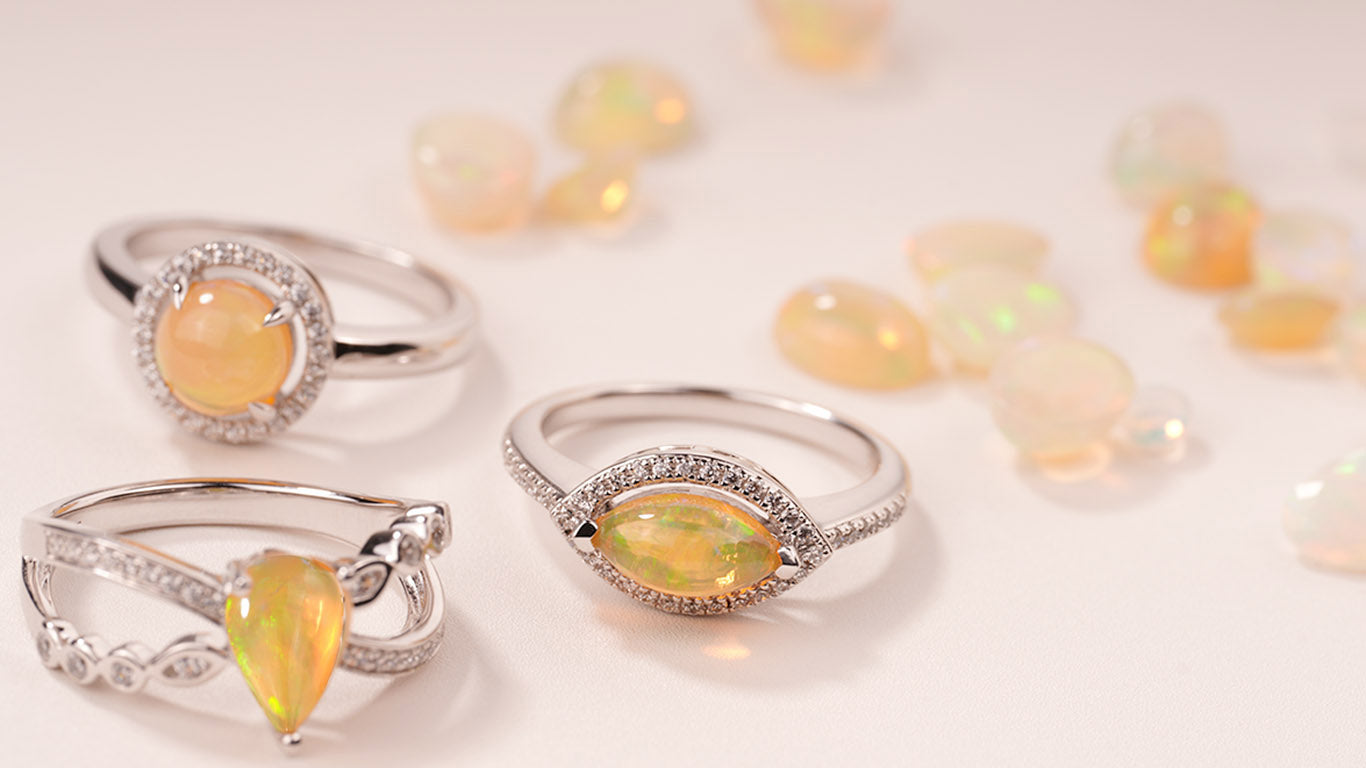
Opal Gemstone Overview
FAQ:
|
1. What Is Opal? |
7. Five Types of Opal |
|
2. How Is Opal Formed? |
8. Opal symbolism |
|
3.Properties of Opal |
9. Why Is Opal So Expensive? |
|
4. Why Does Opal Have So Many Color Variations?
|
10. Opal Jewelry Designs
|
| 5. Natural vs. Synthetic Opal |
11. Opal Care and Cleaning
|
| 6. Identify Natural Opal and Lab Opal |
12.Conclusion
|
Opal has captivated countless people over the years with its brilliant colors. As the October birthstone and a gem known for its unique beauty, opal is both a geological wonder and a cultural treasure. This blog will introduce details about the origin of opal, how it forms, types of opal, benefits, legends, and the difference between natural and synthetic opal.
What Is Opal?

Wikipedia tells us that opal is a hydrated amorphous form of silica (SiO₂·nH₂O), containing 3% to 21% water by weight, typically 6% to 10%.
Opal is the official 14th anniversary stone and is also the birthstone for October. Actually, opal is not a mineraloid because it does not have a crystalline structure like quartz, but it does not have crystals with sharp boundaries. Opal’s most notable feature is its play of color, or more precisely, the light rays that pass through its surface at different angles due to diffraction. Precious opal is coveted for its brilliant color, a beauty that common opal lacks. It occurs in many rock types: sandstone, basalt, and limonite are a few. Because of its otherworldly appeal, opal is popular in jewelry.
How Is Opal Formed?
The formation of opal is a fascinating geological process that spans millions of years. It begins with silica-rich water seeping into cracks and cavities in rock, often in arid regions such as the Australian Outback. Seasonal rains dissolve silica from sandstone or volcanic ash and carry it underground. During dry periods, as the water evaporates, silica gel solidifies in the cracks, forming opal.
In addition, some people believe that acidic conditions must have existed during the formation of the silica spheres, and these acidic conditions may have been generated by microorganisms.
Many opals are milky white and contain silica, but since they do not change color, they are not valuable. Learn more at the Geological Society.
Properties of Opal
- Hardness 5.5-6.5
- Optics Mexican opal as low as 1.37, usually 1.42-1.43.
- Refractive Index 1.37-1.47
- Specific Gravity Maximum range: 1.25-2.23.
- Color: Generally white, black, orange-red, blue, green, grey and fire red.
- Transparency: Transparent to opaque
Why Does Opal Have So Many Color Variations?
Opal comes in a stunning array of colors, from white and transparent to cool blue, green, yellow, fiery red and even black, due to its unique structure.
This play-of-color is caused by the diffraction of light as it passes through silica spheres arranged in a three-dimensional grid. The size of the spheres can also determine the color: 300-nanometer larger spheres appear red, while 150-nanometer appear blue.
The reasons for the color variation are as follows:
- Geological conditions: Trace elements such as iron oxide and graphite can form black opal.
- Sphere arrangement: Microscopic differences in the arrangement of the spheres can produce different patterns in opal.
- Origin: Opal produced in different places has different colors due to different environments. Australian opal is brightly colored, while Ethiopian opal may be more transparent.
Natural vs. Synthetic Opal
How to identify natural Opal and lab-created opal? You first need to know how to form a Synthetic Opal.
Although the method of synthesizing opal is kept secret, it is generally divided into three steps:
1. Forming silica spheres
Add strong alkali to alcohol and water containing silica to turn the Silicone compounds into spheres.
2. Precipitation
Allow silica oxide to precipitate and let the spheres arrange themselves naturally and precisely. This process may take a long time, potentially up to a year.
3. Compaction and Bonding
This process is the most challenging. It may involve using hydrostatic pressure to compact the silica oxide or adding colloidal silica to bond the particles together.
◦ Formed naturally, millions of years ago. ◦ Unique, irregular play of color. ◦ Higher value, especially black opal and crystal opal. ◦ High water content, prone to cracking if not handled properly. |
◦ Lab-made using controlled silica spheres. ◦ Patterns are uniform and sometimes too perfect. ◦ Affordable, durable, and consistent quality. ◦ Lacks the rarity and uniqueness of natural opal. |
Natural opal is prized for its authenticity, while synthetic opal is suitable for budget-conscious buyers.
Welcome to explore Luo Jewelry to get natural opal jewelrys.
How can natural Opal and lab Opal be identified?
How to Tell If an Opal Is Real? In appearance, there is almost no difference between synthetic opal and natural opal, but the difference can be seen through careful identification.
In appearance, synthetic opal and natural opal are almost indistinguishable, but the difference can be seen with careful identification.
- Structure: The color spots of synthetic opal are often arranged in columns, and each mosaic has a snakeskin and honeycomb structure, but the color spots of natural opal are irregular flakes.
- Luminescence: Natural opal will have a continuous glittering light, but synthetic opal has almost none.
- Infrared spectrum: The vibration of water molecules in synthetic opal and natural opal is quite different.
5 Types of Opal
White Opal

White opal is milky white to light grey with subtle play of colour. Most of it is mined in Australia. Its silica spheres are larger and more uneven, which allows light to diffuse softly.
This opal is more affordable than other colours.
Crystal Opal
Crystal opal is similar in colour to white opal, transparent to translucent with bright play of colour. It is difficult to distinguish between white opal and crystal opal with the naked eye, but white opal has a frosted texture, which is the main difference. Crystal opal is mined in Australia and Ethiopia. The biggest feature is its clear matrix that allows light to penetrate deeply. It is perfect for making elegant pendants and earrings.
Black Opal

Black opal from Lightning Ridge, Australia is mainly black and dark grey with bright flashes of colour.
This is due to trace elements of carbon or iron oxide that darken it.
Because it is relatively rare and expensive, this black opal is generally seen in high-end jewellery. It is also sold in Luo Jewelry. If you like black opal, you can contact customer service for customization.
Pink opal

Pink opal is very cute, usually with a color ranging from bright light pink to pink white. Most of it is produced in Peru and Australia.
It is worth noting that wearing pink opal ring jewelry needs to avoid direct sunlight, otherwise it may cause cracking
Blue opal

Blue opal is produced in the land of camels and Machu Picchu. The color is between blue and blue-green. It has its own unique meaning and legend. If you want to know more, you can click on the name to see more content.
Fire opal
 Because the color of fire opal is translucent yellow, orange or red, it is very eye-catching and very suitable as a fire opal ring of courage and declaration.
Because the color of fire opal is translucent yellow, orange or red, it is very eye-catching and very suitable as a fire opal ring of courage and declaration.
Boulder Opal
Boulder opal comes in a variety of colors, mostly from Queensland, Australia. This opal is more suitable for durable jewelry than other opals.
Opal symbolism
Indeed, different colors of opal have different meanings and benefits, but as the birthstone for October and the symbol stone for Libra, they also share common characteristics, benefits, and symbolic meanings of wearing.
- Creativity: Inspires imagination and artistic expression.
- Emotional balance: Helps achieve calm and harmony for healing or emotional healing.
- Intuition: Increases awareness for psychic and spiritual growth
- Guardianship: White opal is said to have guardian and cleansing properties. These are the properties that this mineral generally possesses, making it a leading choice in crystal healing, even though there is no scientific evidence to support its efficacy.
Opal Care and Cleaning
Opal is soft (Mohs hardness 5.5-6.5) and has a high water content, so it needs careful care:
- Opal is very sensitive to temperature. Do not use overheated water to wash it. Use lukewarm water and mild dish soap
- Use a soft brush to scrub gently. If you use a toothbrush, use a soft brush with a hardness of less than five.
- Avoid using ultrasonic cleaners, high temperatures, and chemicals (such as perfumes and lotions).
- If not worn, store opal separately in a soft fresh-keeping bag to prevent scratches. Also avoid exposure to the sun, which can easily cause opal to dehydrate and crack.
Why Is Opal So Expensive?
Opal's value varies by type, quality and rarity. Black opal, due to its vivid play-of-color and scarcity, is the most expensive.
Why are opals so expensive?
- Play-of-color: Intense, broad-spectrum flashes of color increase their value.
- Rarity: Black opal is extremely rare and found primarily in one region of Australia.
- Craftsmanship: Cutting opal to bring out its best color requires skill, which increases the cost.
Opal Pricing Factors

Opal Jewelry Designs

Conclusion
Opal's fascinating colors, rich history, and diverse uses make it an irreplaceable gemstone. If you want to know more about gemstones, please subscribe to us. We will frequently update new blogs, introducing gemstones and jewelry.
